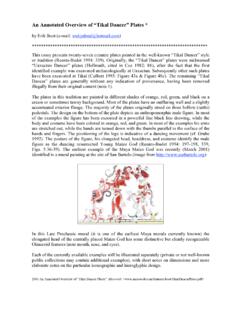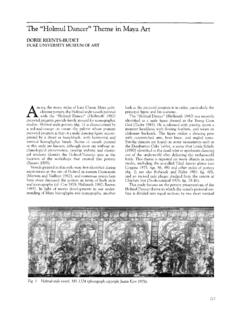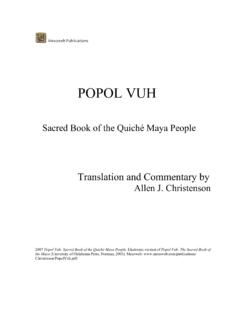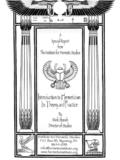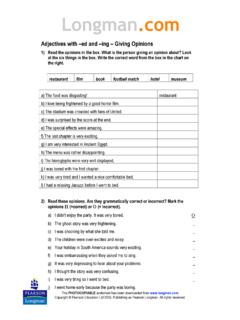Transcription of Updated - Mesoweb
1 The Updated Preliminary Classic Maya English, English Classic Maya Vocabulary of Hieroglyphic Readings Including nouns, adjectives, verb roots, verb inflections, pronouns, toponyms, a selection of proper names of objects, animals, and buildings, as well as a selection of nominal phrases of deities, supernatural entities, and historic individuals Authored and compiled by Erik Boot (email: April 2009 (version ) Mesoweb Resources URL For updates, please check: URL Front cover: Photograph by Linda Schele, David Schele, courtesy Foundation for the Advancement of Mesoamerican Studies, Inc.)
2 , Photograph shows part of the back inscription on Tikal Stela 31 Front cover design: Erik Boot Font: Palatino Linotype For the main text: Palantino Linotype set at pnts, for footnotes at 10 pnts. Times New Roman at pnts (main text) and 10 pnts (footnotes) for all hyphens About the author and compiler: Erik Boot received his from Leiden University, the Netherlands. His dissertation, published in 2005 by Research School CNWS, is concerned with the origin and history of the Aj Itza of the central Peten and the northern Maya lowlands capital city of Chichen Itza, Yucatan. He is an independent researcher, who maintains three weblogs: M a y a N e w s U p d a t e s ( ) A n c i e n t M e s o A m e r i c a N e w s U p d a t e s (http://ancient mesoamerica news ) M a y a G l y p h B l o g (http://maya glyph ) Table of Contents Preface ii Introduction 1 Part 1: The Classic Maya English Vocabulary 12 Part 2: The English Classic Maya Vocabulary 215 Appendix A: Abbreviations, Monument Designations, and Site Codes 232 Appendix B.
3 Classic Maya Numerals 239 Appendix C: Classic Maya Numeral Classifiers 241 Appendix D: Classic Maya Names of the 20 day and 5 day Periods 241 Appendix E: Classic Maya Pronouns 245 Appendix F: Classic Maya Verb Roots 246 Appendix G: Classic Maya Kinship Terms 250 Appendix H: Classic Maya Animal Names 251 ii Preface In 2002, the original version of the preliminary vocabulary of Maya hieroglyphic spellings was posted at Mesoweb . During the seven years since the publication of the vocabulary important advances have been made in the decipherment of Maya writing and it was time to update the vocabulary.
4 This update was also instigated by the disappearance of my original database, which was lost in a severe computer crash in October of 2006. On this occasion I like to express my acknowledgments. In the first place I thank Joel Skidmore for hosting the original and the Updated preliminary Maya English, English Maya vocabulary of hieroglyphic readings. Additionally, I thank him for his kind permission to include a selection of photographs from the Mesoweb PARI Photo Database. I thank Dr. Sandra Noble, director of the Foundation for the Advancement of Meso american Studies, Inc., for her kind permission to employ a photograph of the back side of Tikal Stela 31, made by Linda Schele, which appears on the front cover of this vocabulary.
5 I also thank Justin Kerr for his kind permission to include a small selection of texts elicited from the Mesoamerican Portfolio and The Maya Vase Data Base, both hosted on the web by the Foundation for the Advancement of Mesoamerican Studies, Inc. For suggestions, corrections, additions, etc., in regard to the original preliminary vocabulary as well as several versions of the Updated preliminary vocabulary, I thank, in alphabetical order, Jeff Buechler, Carl Callaway, Christophe Helmke, Jenn Newman, Carlos Pallan, Christian Prager, Joel Skidmore, Mark Van Stone, Erik Vel squez, and Gordon Whittaker. For the final result, including each and every remaining mistake and/or fallacy (typos included!)
6 , I solely bear the responsibility. As this Updated vocabulary is work in progress, comments, suggestions, additions (with an image of the hieroglyphic text), corrections, etc., are always welcome at my email address (see cover page). Please use Updated vocabulary in the subject line. 1 Introduction This is the Updated preliminary Classic Maya English, English Classic Maya vocabulary. During the period of June 2007 March 2009, the original vocabulary (Boot 2002) was checked, revised, reduced, enlarged, and is now annotated in close to 300 cases. The Updated version of this preliminary vocabulary of hieroglyphic readings (still a precursor to a fully illustrated vocabulary) contains some 1,275 main entries, each defined with a minimum of one transcribed glyph example (over 2,500 transcription examples).
7 The Updated English Classic Maya vocabulary contains over 530 entries. At present, it is not possible to add to each entry the name(s) of the epigrapher(s) who presented the decipherment or reading in question first or with the most convincing argument. For those interested in the history of decipherment, I direct the reader to Coe s 1992 book Breaking the Maya Code, as well as to an important compilation entitled The Decipherment of Ancient Maya Writing (Houston, Chinchilla M., and Stuart 2001), containing many of the landmark articles which have been pivotal to the decipherment of Maya writing. Also, two extensive explanatory glyph identification listings are available.
8 First, the listing compiled by John Justeson, published in 1984; second, the listing compiled by Kornelia Kurbjuhn, published in 1989. Both listings identify the glyphic signs according to the numbers as allocated by J. Eric S. Thompson in his 1962 catalog. Most of the glyph identifications have multiple entries by different epigraphers and through these entries it can be seen that not all epigraphers agree on certain decipherments, while other decipher ments are simply outdated. It also has to be noted that more recent decipherments are not included in these listings (1988 and onwards). For those readings, the reader may turn to a section entitled Known Glyphs and Expressions in the recent notebooks for the Texas Maya Meetings, held every year in March in Austin, Texas.
9 In an elegant way, the late Linda Schele (1954 1998) introduced specific new decipherments, the epigraphers who presented these decipherments, and the applications and implications of those decipherments ( , Schele 1998: 34 55). Since the initial posting of the preliminary vocabulary in January of 2002, two illustrated dictionaries have appeared: Dictionary of Maya Hieroglyphs by the late John Montgomery (2002) and, online at the FAMSI website, the Maya Hieroglyph Dictionary by Peter Mathews and Peter B r (2006). A short illustrated word list can be found in Reading the Maya Hieroglyphs, written and illustrated by Michael Coe and Mark Van Stone (2001).
10 The entries in the original and this Updated preliminary vocabulary have been elicited from hieroglyphic texts (either carved, incised, or painted) on stone and wooden monuments (stelae, lintels, altars, etc.), on portable objects of stone, wood, bone, and shell, in murals, on cave walls, on ceramics, and in three of the four surviving screenfold books. For this vocabulary, I present entries in compliance with the following phonemic orthography, through which the vocabulary is also organized, and which in alphabetic order reads: , a, b, ch, ch , e, h, i, k, k , l, m, n, o, p, p , s, t, t , tz, tz , u, w, x, and y.



